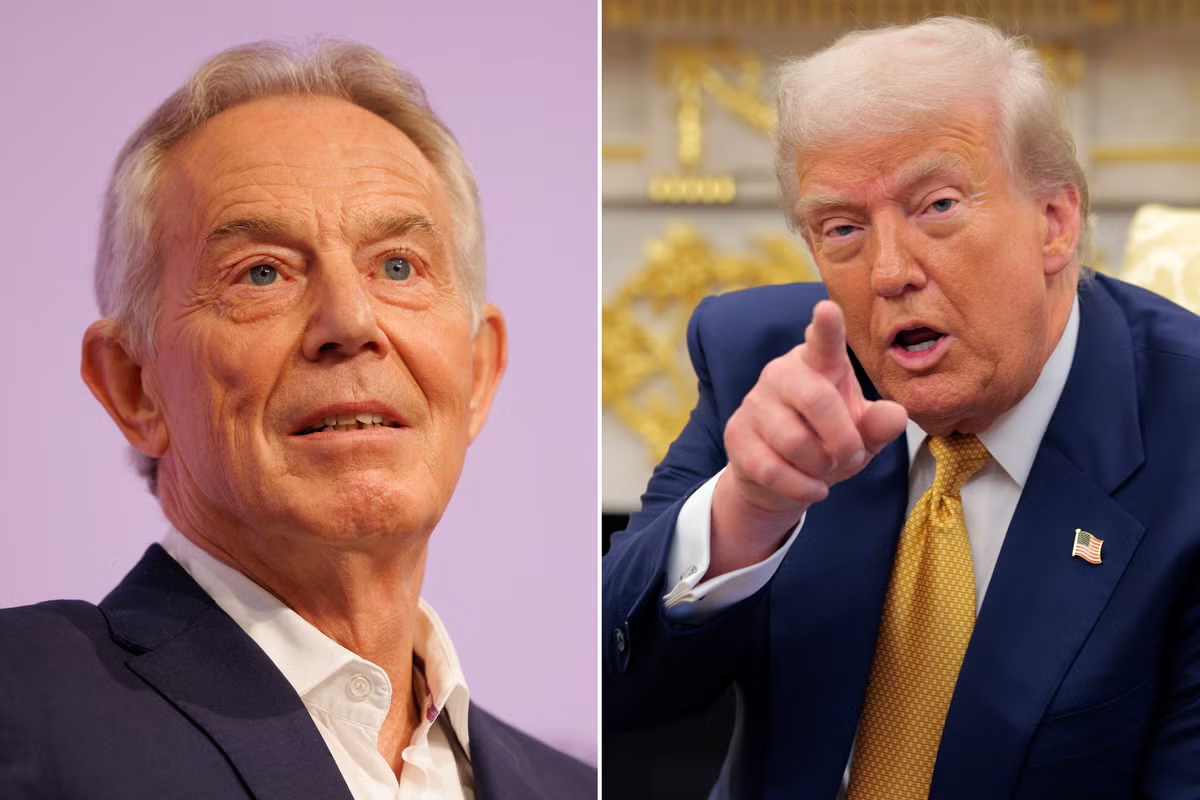- Tony Blair’s Longstanding Role in the Middle East
- Trump’s Complicated Relationship with Gaza
- Why Blair’s White House Visit Matters
- Reactions from Global Leaders and Analysts
- The Humanitarian Crisis in Gaza: The Context of the Meeting
- Storytelling: A Diplomatic Surprise
- What Does This Mean for Trump’s Gaza Strategy?
- The Political Angle: Trump’s Calculations
- Historical Context: U.S.-UK Cooperation in the Middle East
- Expert Opinions
- Public Perception and Media Coverage
- Lessons for the Future of Gaza Diplomacy
- FAQs
- Conclusion
The corridors of Washington are no strangers to high-profile visits, but few have stirred as much intrigue as former British Prime Minister Tony Blair’s surprise appearance at the White House. Blair’s unannounced meeting with former U.S. President Donald Trump has ignited speculation over its timing, agenda, and potential impact, particularly as the situation in Gaza remains volatile and central to international diplomacy.
Observers have been quick to question: Why Blair? Why now? And what does his meeting with Trump signal about the future of American strategy in the Middle East, especially as the humanitarian crisis in Gaza deepens?
This article delves into every dimension of this surprise visit, exploring the history of Blair’s involvement in Middle East affairs, Trump’s evolving Gaza strategy, reactions from global leaders, and the broader implications for peace and security in the region.
Tony Blair’s Longstanding Role in the Middle East
Tony Blair is no stranger to the complexities of Middle Eastern politics. Since stepping down as the UK’s Prime Minister in 2007, he has often played the role of special envoy, mediator, and advisor in the region.
Blair’s Past Work in Gaza and Palestine
- In 2007, Blair became the Middle East Quartet’s special envoy, representing the U.S., EU, UN, and Russia.
- He focused on Palestinian economic development, institution building, and easing restrictions in Gaza and the West Bank.
- Though critics claimed his efforts lacked tangible results, Blair maintained access to top leaders in Israel, Palestine, and across the Arab world.
His network and reputation as a seasoned negotiator make him a familiar figure in Gaza-related diplomacy. Yet his sudden reemergence in Washington alongside Trump has raised eyebrows about whether his presence signals a new diplomatic initiative—or a political maneuver by Trump.
Trump’s Complicated Relationship with Gaza
Trump’s policies toward Israel and Palestine have always been polarizing.
Key Actions During Trump’s Presidency
- Recognition of Jerusalem as Israel’s capital in 2017.
- Relocation of the U.S. Embassy from Tel Aviv to Jerusalem.
- Cutting $200 million in aid to Palestinians in 2018.
- Unveiling the “Peace to Prosperity” plan in 2020, which was rejected by Palestinians as biased toward Israel.
While Trump framed his approach as bold and pragmatic, critics argued it marginalized Palestinian interests and worsened tensions in Gaza.
Now, with Blair’s sudden appearance, questions are mounting: Is Trump reconsidering his Gaza approach? Or is this meeting more about political optics than substantive diplomacy?
Why Blair’s White House Visit Matters
The surprise nature of Blair’s trip has led analysts to interpret it in multiple ways.
Three Possible Explanations
- Advisory Role: Trump may be seeking Blair’s expertise on navigating the Gaza crisis, particularly given Blair’s history in the region.
- Political Signaling: The meeting could be an attempt by Trump to show international engagement ahead of domestic political milestones.
- Backchannel Diplomacy: Blair could be acting as a mediator, carrying messages between Washington, Tel Aviv, and Arab capitals.
Reactions from Global Leaders and Analysts
The visit has not gone unnoticed in diplomatic circles.
European Reaction
Several European officials expressed surprise, noting that Blair had not held such a visible role in Middle East diplomacy for years. One EU diplomat was quoted saying, “If Blair is in Washington, it means something is shifting behind the scenes.”
Middle Eastern Response
Reactions in the Middle East were mixed:
- Israeli officials welcomed the meeting, viewing Blair as a trusted partner.
- Palestinian leaders, however, were more skeptical, fearing Blair might reinforce policies tilted in Israel’s favor.
American Analysts
U.S. foreign policy experts noted that Trump’s reliance on Blair might reflect a lack of credible advisors on Gaza within his own circle. Others saw it as a publicity move to distract from domestic controversies.
The Humanitarian Crisis in Gaza: The Context of the Meeting
Any discussion of Trump’s Gaza strategy must acknowledge the humanitarian realities on the ground.
Current Situation in Gaza
- Over 2 million Palestinians live in the Gaza Strip, with nearly half under the age of 18.
- According to humanitarian agencies, over 80% of residents rely on aid for survival.
- Unemployment rates hover above 45%, among the highest in the world.
- Ongoing Israeli blockades and internal governance challenges by Hamas exacerbate the crisis.
Blair’s history as a negotiator and Trump’s controversial record make their meeting appear highly significant against this backdrop.
Storytelling: A Diplomatic Surprise
When Blair was spotted walking through the White House’s West Wing, journalists scrambled to confirm his agenda. A White House insider, speaking on condition of anonymity, described the atmosphere as “tense but purposeful.”
Some staffers reportedly joked that Blair had become the “ghost of Gaza past,” reappearing at a critical moment to revisit a decades-old conflict that still defies resolution.
What Does This Mean for Trump’s Gaza Strategy?
While the specifics of the meeting remain undisclosed, several possible outcomes are being debated.
Potential Shifts in Policy
- Trump might consider a softer stance on humanitarian aid to Gaza as a strategic move to win broader support.
- Blair could advise Trump on re-engaging Arab states in talks, using his relationships in the region.
- Alternatively, the meeting could simply be about optics, with little real impact on policy.
The Political Angle: Trump’s Calculations
Domestic politics may also be a key factor.
Why Now?
- Trump is known for creating dramatic moments that dominate news cycles.
- With elections approaching, showcasing an international statesman like Blair could bolster Trump’s image as a global dealmaker.
- Critics argue this is more about political theater than meaningful diplomacy.
Historical Context: U.S.-UK Cooperation in the Middle East
Blair’s visit also underscores the deep, though sometimes controversial, partnership between U.S. and UK leaders in Middle East affairs.
- Blair worked closely with President George W. Bush during the Iraq War.
- Critics labeled Blair as being “too close” to U.S. foreign policy.
- This history adds to the speculation that his current role may align with American objectives rather than independent mediation.
Expert Opinions
Several experts have weighed in:
- Dr. Hanan Ashrawi, Palestinian academic: “Blair’s record in the region is one of failure. His involvement now raises doubts about the sincerity of any peace effort.”
- Richard Haass, U.S. foreign policy expert: “Trump may see Blair as a useful intermediary, but real progress will require structural policy changes, not symbolic meetings.”
Public Perception and Media Coverage
The media has framed Blair’s visit as a diplomatic shockwave. Headlines in both American and European outlets emphasized the secrecy surrounding the meeting.
On social media, reactions ranged from cautious optimism to outright skepticism, with many questioning whether any real progress would emerge from the encounter.
Lessons for the Future of Gaza Diplomacy
Blair’s appearance at the White House reminds the world of three critical lessons in Gaza diplomacy:
- Symbolism Matters: High-profile meetings shape narratives even when policy changes are uncertain.
- Trust Deficit: Palestinian leaders remain wary of Blair and Trump, complicating any negotiations.
- Need for Comprehensive Solutions: Humanitarian, political, and security dimensions must all be addressed for meaningful progress.
FAQs
Why did Tony Blair visit the White House?
Blair’s surprise visit is believed to be linked to Trump’s Gaza strategy, though the exact agenda remains undisclosed.
What role has Tony Blair played in Gaza before?
He served as the Middle East Quartet’s envoy, working on Palestinian economic development and institution building.
How has Trump approached Gaza in the past?
Trump recognized Jerusalem as Israel’s capital, cut aid to Palestinians, and proposed a controversial peace plan criticized as biased.
What are the possible outcomes of Blair’s meeting with Trump?
It could lead to renewed humanitarian aid, backchannel diplomacy, or simply serve as political theater.
How are Palestinians reacting to the visit?
Many remain skeptical, viewing Blair as too aligned with Western and Israeli interests.
Conclusion
Tony Blair’s surprise White House visit has reignited debate over Donald Trump’s Gaza strategy, sparking questions about whether this meeting marks a genuine diplomatic push or a calculated political move.
While Blair’s deep ties to Middle East diplomacy make him a familiar figure, his credibility remains contested, particularly among Palestinians. For Trump, the meeting provides a chance to reframe his role in global affairs, even as critics dismiss it as optics.
Ultimately, the real measure of this encounter will be whether it translates into tangible improvements for the people of Gaza, who continue to face one of the world’s most protracted humanitarian crises. Until then, Blair’s sudden appearance remains a powerful symbol of how diplomacy in the Middle East often blends intrigue, politics, and high stakes — with uncertain outcomes.








